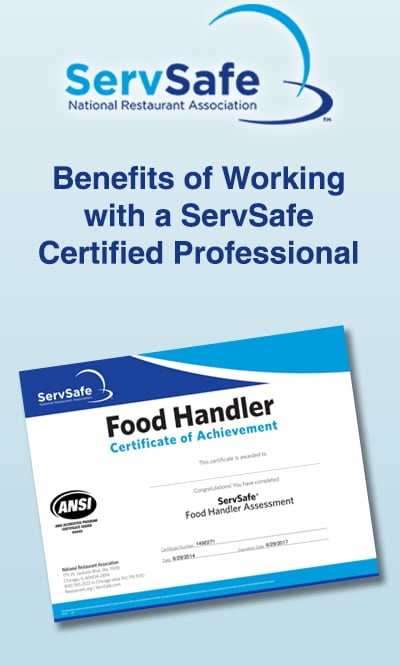Comprehensive Food Handlers Training for Health and Security
In today's quickly progressing food service landscape, comprehensive food handlers training has emerged as a critical component for making sure hygiene and safety and security. By instilling vital practices related to hand hygiene, food storage, and sanitation, this training not only mitigates the threat of foodborne health problems yet additionally strengthens compliance with regulatory criteria.
Importance of Food Security Training

In addition, food safety training assists to make sure that staff members recognize present guidelines and standards, which are vital for keeping functional licenses and avoiding costly charges. Normal training sessions likewise serve as a platform for strengthening best techniques, thereby reducing the probability of human mistake, which often works as a leading source of food contamination.
Additionally, spending in food safety and security training can boost an establishment's track record, as clients progressively focus on eating experiences that mirror high safety and security criteria. Such proactive steps not only protect customers however likewise add to the long-lasting success of food services. In summary, extensive food safety training is an important component of food solution operations, directly affecting both public health and business sustainability.
Trick Concepts of Hygiene
Keeping high criteria of health is necessary in any type of food dealing with atmosphere to stop contamination and make sure the security of consumers. The essential principles of hygiene include a number of important methods that food trainers need to constantly apply.
First, hand hygiene is extremely important; food trainers should wash their hands thoroughly with soap and water prior to and after dealing with food, along with after using the restroom or touching any kind of possibly infected surface areas. Second of all, devices and surface areas must be on a regular basis cleansed and sanitized to remove microorganisms. This consists of utensils, cutting boards, and counter tops, which should be kept in a clean problem.


Correct food storage is additionally vital; raw foods should be kept individually from prepared or ready-to-eat items to avoid cross-contamination. servsafe food handler. Furthermore, keeping appropriate temperature level controls is critical; subject to spoiling things should be maintained safe temperature levels to prevent microbial growth
Last but not least, personal hygiene can not be overlooked. Food trainers should wear tidy clothing, usage hair restraints, and stay clear of working when ill. By sticking to these vital concepts of hygiene, food handlers can substantially minimize the risk of foodborne health problems and promote a more secure eating experience for all customers.
Common Foodborne Illnesses
Although several foodborne diseases can be stopped through correct health and risk-free food handling techniques, they continue to be a significant public health and wellness concern. Foodborne pathogens can result in a range of ailments, ranging from mild stomach distress to extreme problems and even death.
Common foodborne diseases include salmonellosis, created by Salmonella bacteria, frequently connected to undercooked poultry and eggs. Another prevalent health problem is listeriosis, associated with raw dairy products and ready-to-eat meats, which can be specifically unsafe for expectant ladies and immunocompromised individuals. Norovirus, regularly contracted from contaminated food or surface areas, is recognized for its quick spread and ability to trigger episodes in common settings.
Escherichia coli (E. coli) infection, significantly linked with undercooked ground beef and polluted fruit and vegetables, can bring about serious abdominal cramps and kidney failing in some cases. Furthermore, Clostridium perfringens, commonly found in huge quantities of food that are poorly kept, can cause food poisoning with signs and symptoms showing up shortly after consumption.
Understanding these health problems is important for food handlers, as recognition can significantly you could try this out reduce the danger of contamination and protect public health. Proper education and training are vital parts in combating foodborne diseases.
Finest Practices for Food Handling
Effective food managing techniques are important in stopping the spread of foodborne illnesses. Correct hand health is important; food handlers need to clean their hands extensively with soap and water before and after managing food, particularly raw meat or chicken. This simple activity substantially minimizes the risk of cross-contamination
Second of all, keeping ideal food storage temperature levels is vital. Perishable items must be saved at or listed below 40 ° F(4 ° C) to hinder bacterial growth. In addition, prepared foods should be kept above 140 ° F(60 ° C) until served.
Finally, making certain cleanliness of surfaces and equipment is crucial. On a regular basis sterilize kitchen counters, cutting boards, and utensils, particularly after preparing raw foods. Usage different cutting boards for raw and ready-to-eat foods to additionally lessen contamination threats.
Additionally, when preparing food, it is necessary to follow the principle of "very first in, initially out" (FIFO) to take care of inventory effectively and decrease perishing. Finally, always review and stick to food item labels for secure cooking temperature levels and managing instructions. By implementing these ideal methods, food handlers can significantly enhance food security and safeguard public see post health and wellness.
Executing a Security Culture
Creating redirected here a safety society within a food managing atmosphere is necessary for promoting a dedication to food security among all team member. This culture stresses the significance of food safety and security as a common obligation, encouraging workers to focus on hygiene practices continually.
To implement a safety and security culture, organizations must start by supplying extensive training that resolves food handling protocols, possible risks, and the importance of individual hygiene. Educating sessions ought to be interactive and tailored to the certain roles of employee, ensuring relevance and interaction.
Moreover, leadership plays an important role in developing this society. Administration must design risk-free practices and interact the importance of food security regularly. Recognizing and awarding staff members who support safety and security standards can additionally enhance these behaviors.
Furthermore, open interaction networks need to be established, enabling personnel to report safety and security problems without worry of effect. Routine safety audits and comments sessions can help identify locations for renovation and strengthen liability.
Inevitably, growing a security culture not just boosts conformity with food safety guidelines yet additionally safeguards public health and wellness, promotes worker spirits, and adds to the total success of the food handling facility.
Verdict
To conclude, extensive food handlers training plays a pivotal role in advertising hygiene and safety and security within food solution establishments. By furnishing workers with vital understanding about food safety and security principles, common foodborne ailments, and finest practices for taking care of food, such training dramatically minimizes health threats. Moreover, fostering a culture of safety and security enhances the establishment's credibility and aligns with customer expectations for high safety and security standards, ultimately adding to public health defense and the general success of the food service sector.
In today's swiftly developing food solution landscape, extensive food trainers training has arised as a crucial part for guaranteeing health and safety.Food security training is crucial for preserving high criteria in food handling and preparation, with research studies showing that proper training can minimize foodborne illnesses by up to 30%. In summary, thorough food safety training is a crucial element of food service procedures, straight impacting both public health and service sustainability.
